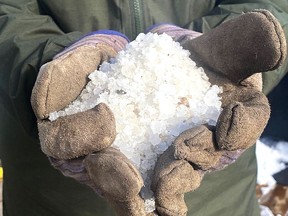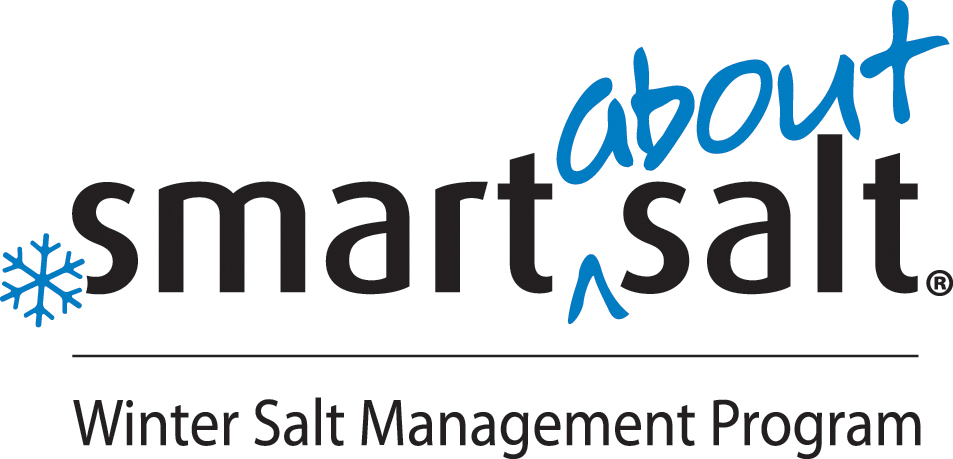Municipal leaders advocating for provincial action on salt pollution at AMO | Kenora Miner
 Road salt is used to provide traction on roadways and sidewalks, but it can also be harmful to the environment. Ian MacAlpine/The Kingston Whig-Standard/Postmedia Network Photo by Ian MacAlpine /The Whig-Standard
Road salt is used to provide traction on roadways and sidewalks, but it can also be harmful to the environment. Ian MacAlpine/The Kingston Whig-Standard/Postmedia Network Photo by Ian MacAlpine /The Whig-Standard
Article content
Mitigating impacts of salt on our ecosystem is top of mind among the province’s municipal leaders.
Awareness has been growing about the impact of salt on Ontario’s iconic freshwater ecosystems, and diverse groups have been advocating for a solution to salt pollution. This includes 19 municipalities, two Conservation Authorities, and counting that support an approach to curbing winter salt impacts called “limited liability” ﹣a solution proposed by the snow and ice management industry, locally represented by Landscape Ontario.
Members of the Ontario Salt Pollution Coalition (OSPC) have been coordinating a provincial advocacy campaign for nearly two years and will be in Ottawa for the Association of Municipalities of Ontario’s annual meeting, (through Aug. 20) to meet interested municipal officials.
As snow plowing businesses face steep insurance costs to cover the possibility of slip and fall lawsuits, some are getting out of the business. Landscape Ontario and the Ontario Salt Pollution Coalition are advocating for a suite of tools that have been used effectively in other wintry places called “limited liability.” In a limited liability regime, snow plow operators and site owners both would follow prescribed rules to standardized operational best management practices, as well as participate in annual contractor certification programs. In return, they would have their liability for slip and fall lawsuits limited. This would reduce salt application rates, save money on salt expenditures, and reverse skyrocketing insurance costs for contractors.
Currently, there are no provincial standards for salt use.
Nineteen municipalities have passed a resolution calling on the Province of Ontario to convene a key stakeholder committee to inform better provincial policy on salt pollution, including exploring limited liability approaches and establishing provincially endorsed Best Management Practices (BMPs). Reduced winter contractor costs from following provincially-endorsed BMPs would also reduce the number of unwarranted slip and fall claims.
King Township was one of them.
A recent motion urges Queen’s Park to create and fund an expert stakeholder advisory committee to advise the Province and municipalities on the best courses of action to protect freshwater ecosystems and drinking water from the impacts of salt pollution.
Further, the motion calls on the Province to “work urgently with key stakeholders to develop limited liability legislation, including enforceable contractor training and a single set of provincially-endorsed standard BMPs for snow and ice management.”
The bottom when it comes to salt application is more is not better, and the concensus around the council table is to look for better practices and a “lighter touch.”
In a subsequent presentation to council, David Lembcke, director of watershed science and monitoring for LSRCA, noted 23 of 26 water quality stations are showing an increasing trend in chloride. Many areas are showing chronic and acute levels.
He stressed it’s possible to reduce application rates while maintaining safety, with a significant cost savings for the municipalities.
The key is obtaining current information, training contractors and give the tools to property managers to make good decisions.
There’s broad support in Ontario, he said, among members of commercial properties, the maintenance industry and water quality groups.
Eighteen businesses and business professionals have already supported the Ontario Salt Pollution Coalition’s advocacy for provincial action through a business sign on letter. “The requested changes could save independent business, municipalities, and taxpayers money, while protecting the environment. We call that a win–win, IF Ontario acts,” says Councillor Jonathan Scott, Chair of Bradford West Gwillimbury’s (BWG) Green Initiatives Advisory Committee.
BWG council also passed a resolution calling on the provincial government to act on salt pollution this spring.
Municipal leaders also care about the millions of dollars per year of infrastructure damage caused by road salt, such as accelerated deterioration of roads and bridges.
The EcoFiscal Commission has estimated the economic and environmental damage of winter salt to Canada at $4.8 billion per year, which would prorate to about $2 billion per year in Ontario. “Reducing salt pollution has long-term environmental cost savings, which we should all support, but it also would reduce the cost of infrastructure repair, which is a significant concern for municipalities,” says Waterloo Councillor Julie Wright, who led the charge to pass a resolution for provincial salt pollution action in Waterloo earlier this year. The council passed the resolution in April unanimously.
Thousands of Ontarians have sent emails to Premier Doug Ford, Minister of Environment, Conservation and Parks Todd McCarthy, and Attorney General Doug Downey asking the province to take action on salt pollution. In February, the District of Muskoka was the first to pass a municipal salt pollution action resolution, under the leadership of District Chair Jeff Lehman. “Residents in Muskoka are passionate about the environment and water quality, as am I,” says Lehman. “This is an important initiative, and a simple ask with much public support and upsides for small town economies and municipalities alike.”
Salt affects the creatures at the bottom of the food chain, which has negative ripple effects across water-based ecosystems, including weakening fish stocks and impacts to sensitive, endangered species like mussels. Ontario’s chloride levels have doubled since the 1960s in the 400 streams and lakes monitored by the province. The Lake Simcoe Region Conservation Authority has been studying chloride since the 1980s as a contaminant of concern.
Following current chloride trajectories, Lake Simcoe ﹣one of Ontario’s largest freshwater lakes ﹣ would reach chronic salinity levels in just over 30 years, effectively collapsing the local food chain and making the lake uninhabitable for most species. As a source of drinking water and a recreational hub, this is an extremely worrying trend, reflected in lakes, rivers, and groundwater sources across the province. Lake Simcoe is just one example of many areas where ignoring this problem will lead to devastating consequences for people and species.
Members of the Ontario Salt Pollution Coalition (OSPC) have been coordinating a provincial advocacy campaign for nearly two years and will be in Ottawa for the Association of Municipalities of Ontario’s annual meeting, (through Aug. 20) to meet interested municipal officials.
At AMO, proponents hope to use their collective power.
“Municipal officials have more power than they think, especially when we act together. The Province is hearing us. The more cities and townships who pass resolutions calling for provincial action on salt pollution, the closer we’ll get to real policy action,” said Dani Lindamood, who is the Campaigns & Communications Director for Water Watchers and one of the lead organizers of the Ontario Salt Pollution Coalition. “Our power is in our collective action.”
The Ontario Salt Pollution Coalition is a collection of concerned community groups, eNGOs, municipal officials, and individuals representing communities from Niagara to Sudbury. The Coalition is focused on addressing the water impacts of salt pollution, including the opportunity to get limited liability changes in Ontario for the Snow and Ice Management Sector, which is an important stepping stone in reducing salt pollution of Ontario’s waterways.
